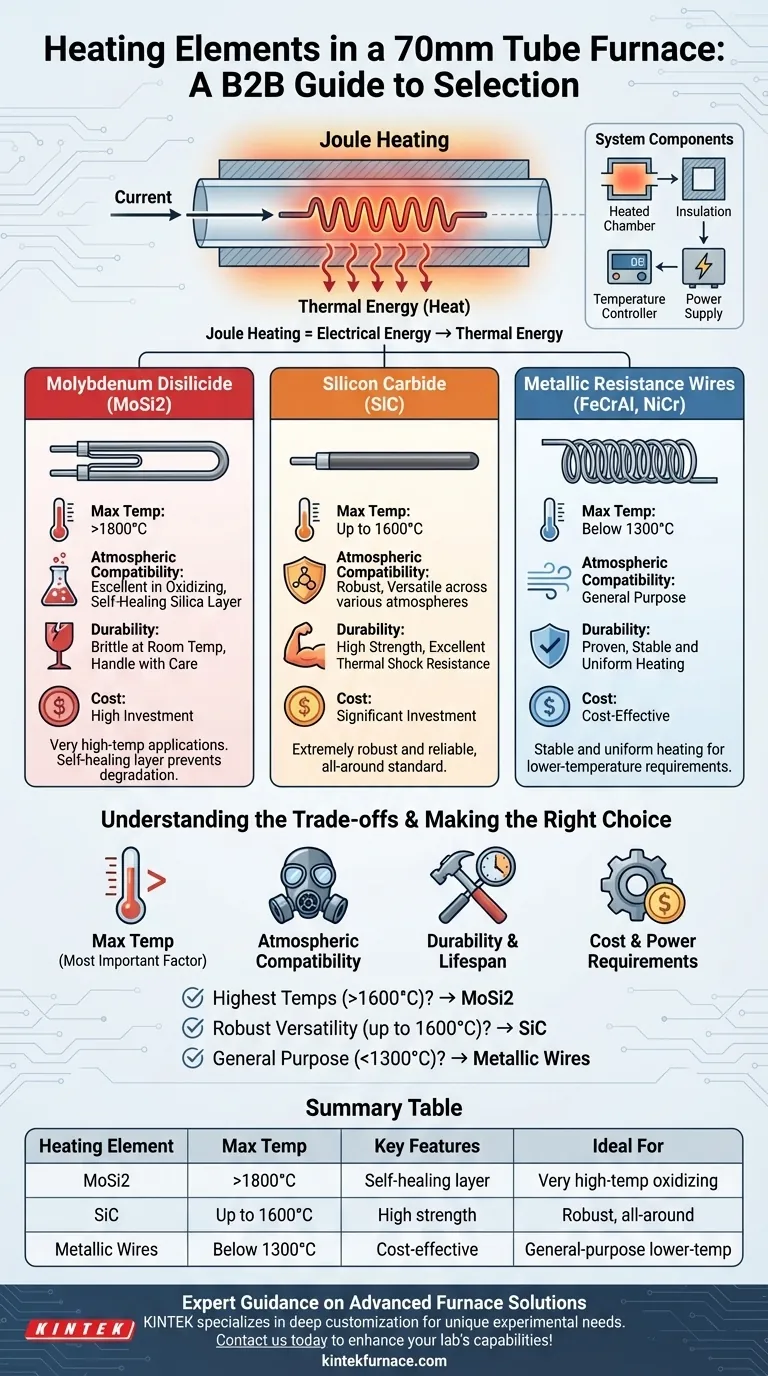For a 70mm tube furnace, the most common heating elements are Molybdenum disilicide (MoSi2) and Silicon carbide (SiC) for high-temperature applications, and metallic resistance wires for lower-temperature requirements. The specific choice is dictated almost entirely by the maximum operating temperature and the chemical atmosphere required for your process.
The heating element is the heart of your furnace. Selecting the right one is not about finding a single "best" material, but about matching the element's distinct properties—specifically its temperature limit and chemical resilience—to the precise demands of your work.
How Resistance Heating Works in a Furnace
The Basic Principle
All of these elements operate on a simple principle known as Joule heating. When a strong electrical current is passed through a material with high electrical resistance, that electrical energy is converted directly into thermal energy, or heat.
The heating element is the component specifically designed to withstand this process at extreme temperatures without melting, oxidizing, or degrading rapidly.
The Role of System Components
The element does not work in isolation. It is part of a system that includes the heated chamber (the tube), high-grade insulation to direct heat inward, a temperature controller for precision, and a power supply to deliver the necessary current.
A Breakdown of Common Heating Elements
Molybdenum Disilicide (MoSi2)
MoSi2 elements are the workhorses for very high-temperature applications, often capable of reaching over 1800°C. They are a ceramic-metallic composite.
Their key advantage is the ability to form a self-healing, protective layer of silica glass on their surface when heated in an oxidizing atmosphere (like air). This layer prevents further degradation of the element.
Silicon Carbide (SiC)
SiC elements are an extremely robust and reliable choice for a wide range of applications, typically operating up to 1600°C. They are known for their high strength and excellent thermal shock resistance.
Unlike MoSi2, SiC elements are generally more versatile and can perform well in a broader variety of atmospheric conditions, making them a very popular all-around standard.
Metallic Resistance Wires
For applications with lower temperature requirements (typically below 1300°C), metallic alloy wires are a common and cost-effective solution.
These are often made of FeCrAl (iron-chromium-aluminum) alloys, sometimes referred to by the trade name Kanthal, or NiCr (nickel-chromium) alloys. They provide stable and uniform heating for many general-purpose thermal processes.
Understanding the Trade-offs
Maximum Operating Temperature
This is the single most important factor. MoSi2 consistently offers the highest temperature ceilings, followed closely by SiC. Metallic wires operate at a significantly lower temperature range. Your process's peak temperature requirement will immediately narrow your options.
Atmospheric Compatibility
MoSi2 elements thrive in air but can be vulnerable to attack in certain reducing or reactive gas atmospheres. SiC is often more durable across a wider range of chemical environments. You must ensure your element is compatible with any process gasses you intend to use.
Durability and Lifespan
SiC is known for its mechanical robustness. MoSi2 elements, while excellent at high temperatures, can be very brittle at room temperature and require careful handling during installation and maintenance. All heating elements are consumables that age over time and will eventually require replacement.
Cost and Power Requirements
Generally, metallic wire elements are the least expensive to purchase and replace. High-performance SiC and MoSi2 elements represent a more significant investment, and their power supplies are often more complex to manage their changing resistance as they heat up.
Making the Right Choice for Your Goal
The 70mm tube size is standard, but the process you run inside it is unique. Use your primary goal to guide your decision.
- If your primary focus is reaching the highest possible temperatures (above 1600°C): Molybdenum disilicide (MoSi2) is the definitive choice for its superior performance in oxidizing atmospheres.
- If your primary focus is robust performance and versatility up to 1600°C: Silicon carbide (SiC) provides an outstanding balance of durability, temperature capability, and atmospheric flexibility.
- If your primary focus is general-purpose heating below 1300°C: Metallic resistance wire elements offer a proven, reliable, and cost-effective solution for your needs.
Understanding these core material differences ensures you select a furnace based on its fundamental performance capabilities, not just its physical dimensions.
Summary Table:
| Heating Element | Max Temperature | Key Features | Ideal For |
|---|---|---|---|
| Molybdenum Disilicide (MoSi2) | >1800°C | Self-healing silica layer, excellent in air | Very high-temp applications in oxidizing atmospheres |
| Silicon Carbide (SiC) | Up to 1600°C | High strength, thermal shock resistance, versatile atmospheres | Robust, all-around high-temp processes |
| Metallic Resistance Wires | Below 1300°C | Cost-effective, stable heating, easy to use | General-purpose lower-temp applications |
Need expert guidance on selecting the right heating element for your 70mm tube furnace? KINTEK specializes in advanced high-temperature furnace solutions, including Muffle, Tube, Rotary, Vacuum & Atmosphere Furnaces, and CVD/PECVD Systems. With our strong R&D and in-house manufacturing, we offer deep customization to precisely meet your unique experimental needs—ensuring optimal performance, durability, and efficiency. Contact us today to discuss how we can enhance your lab's capabilities!
Visual Guide

Related Products
- 1700℃ High Temperature Laboratory Tube Furnace with Quartz or Alumina Tube
- 1400℃ High Temperature Laboratory Tube Furnace with Quartz and Alumina Tube
- High Pressure Laboratory Vacuum Tube Furnace Quartz Tubular Furnace
- Split Multi Heating Zone Rotary Tube Furnace Rotating Tube Furnace
- Multi Zone Laboratory Quartz Tube Furnace Tubular Furnace
People Also Ask
- What are the key operational considerations when using a lab tube furnace? Master Temperature, Atmosphere & Safety
- How does a tube furnace work? Master Precise Heat and Atmosphere Control
- How to clean a tube furnace? A Step-by-Step Guide to Safe and Effective Maintenance
- What recent improvements have been made to lab tube furnaces? Unlock Precision, Automation & Safety
- What is a tubular furnace used for? A Guide to Precise High-Temperature Processing



















